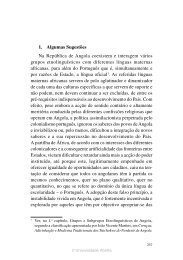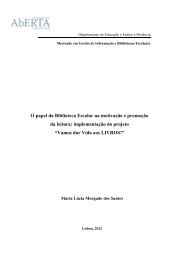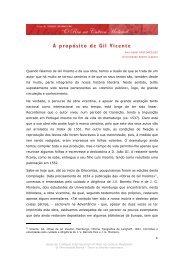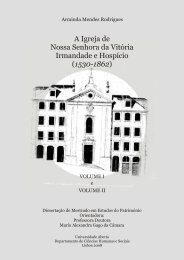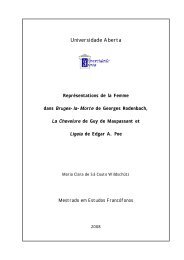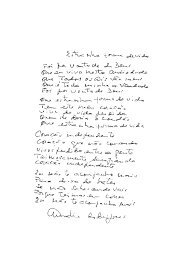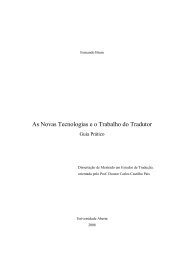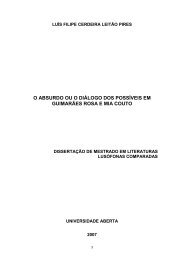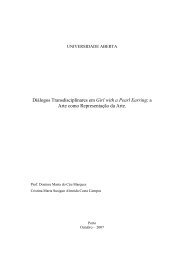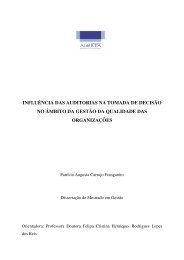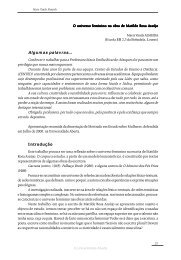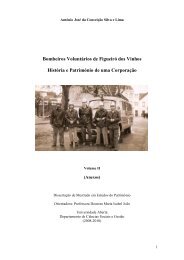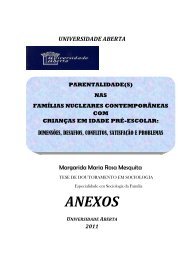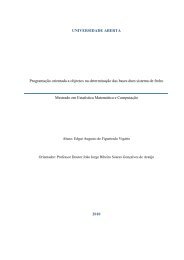NA SENDA DA IMAGEM A Representação ea Tecnologia na Arte
NA SENDA DA IMAGEM A Representação ea Tecnologia na Arte
NA SENDA DA IMAGEM A Representação ea Tecnologia na Arte
Create successful ePaper yourself
Turn your PDF publications into a flip-book with our unique Google optimized e-Paper software.
The possibility to generate 3D shapes from r<strong>ea</strong>l<br />
3D input, i.e. an input device moving freely in<br />
3D space, rather than using CAD paradigms like<br />
a 3D form being extruded, from a profile along<br />
a path in space (as illustrated next):<br />
Fig. 2. 3D shape generated from the paths of 2 lights<br />
moving freely through 3D space.<br />
These interfaces, based on simple, inexpensive,<br />
non intrusive devices, such as web cameras and<br />
small lights, should e<strong>na</strong>ble a non skilled user to<br />
intuitively start designing with no or minimum<br />
CAD skills.<br />
A. Introduction<br />
II. BACKGROUND<br />
This work a<strong>na</strong>lysed a series of projects related<br />
to some sort of free hand form generation. The<br />
projects chosen for more in depth a<strong>na</strong>lysis are<br />
the ones found to approach more directly the<br />
objectives stated before: direct three<br />
dimensio<strong>na</strong>l input, <strong>na</strong>tural interface and a free<br />
hand approach.<br />
i. Sketch-based CAD systems<br />
Perhaps the <strong>ea</strong>rliest computerized sketching<br />
system (in fact the <strong>ea</strong>rliest CAD system) is<br />
Sutherland’s sketchpad [Sutherland, 1963]. In<br />
that system, the user could draw using a light<br />
pen on a screen and manipulate graphic<br />
primitives such as arcs and lines. Since the<br />
development of Sketchpad, numerous graphic<br />
drawing packages have been developed, but<br />
only a few of them have tried to “understand”<br />
the picture being drawn, in the sense that they<br />
detect relationships not explicitly specified by<br />
the user, or connect individual components to<br />
form a “larger context”, as humans may do<br />
when looking as a sketch. Moreover, not many<br />
of these systems support true freehand<br />
sketching, let alone freehand sketches of threedimensio<strong>na</strong>l<br />
objects. Kato et al [Kato, 1982]<br />
describe a system for interactive processing of<br />
2D freehand-sketched diagrams. Jenkins and<br />
Martin [Jenkins, 1993] describe a system called<br />
Easel for online (interactive) freehand sketching<br />
of two dimensio<strong>na</strong>l graphics comprised of lines,<br />
arcs and Bezier curves. Their system is certainly<br />
aimed in the right direction as it attempts to<br />
conform to some of the crucial aspects of<br />
sketching discussed in the previous sections by<br />
accepting direct freehand sketching and<br />
tolerating i<strong>na</strong>ccuracies. The system avoids the<br />
use of menus so as not to impede the cr<strong>ea</strong>tive<br />
process, and therefore automatically<br />
distinguishes between stroke types and infers<br />
implicit constraints among them. Fatos and<br />
Ozguc [Fatos, 1990] describe a system for 2D<br />
architectural sketch recognition with lines, arcs<br />
and corners. Hwang and Ullman [Hwang, 1990]<br />
describe a system for capturing “back of the<br />
envelope” sketches. Eggli et al [Eggli, 1995]<br />
propose a solid modeler incorporating a<br />
sketching tool; their system is three dimensio<strong>na</strong>l<br />
but the sketching itself is always constrained to<br />
some plane, thereby avoiding the problematic<br />
inverse-projection reconstruction phase. A<br />
similar system for designing solid objects using<br />
interactive sketch interpretation is described by<br />
Pugh [Pugh, 1992].<br />
B. Related Work<br />
i. Several 3D Sketch Based Methods<br />
Several systems for modelling by sketching<br />
alr<strong>ea</strong>dy exist. System Sketch [Zeleznik, 1996]<br />
allows the user to cr<strong>ea</strong>te simple geometrical<br />
scenes using a set of predefined gestures. There<br />
are also systems for sketching of CAD drawings<br />
[Lipson, 1997]. These systems are a valuable<br />
help in cr<strong>ea</strong>ting models consisting of<br />
geometrical primitives, but they cannot be used<br />
to model free-form shapes, on which this work<br />
concentrates. Teddy [Igarishi, 1999] is aimed<br />
especially on modelling of simple free-form<br />
objects (like teddy-b<strong>ea</strong>rs). The system is able to<br />
inflate 2D closed curves into 3D objects, which<br />
can be consequently edited using simple<br />
gestures. During the whole modelling process<br />
the system maintains a polygon mesh of the<br />
model, displayed in a non-photo r<strong>ea</strong>listic way.<br />
Another system for free-form modelling was<br />
described by Karpenko et. al. [Karpenko, 2002].<br />
Inst<strong>ea</strong>d of using a polygon mesh, the authors<br />
represent the model by a variatio<strong>na</strong>l implicit<br />
surface. By sketching, the user edits a set of<br />
constraints defining the surface. This work tries<br />
to simulate the drawing process of artists, who<br />
start sketching using simple 3D shapes - blobs,<br />
which are then connected into more complex<br />
shapes and refined.<br />
The ARTHUR project [1] involves the<br />
development of a system to augment round table<br />
design t<strong>ea</strong>m meetings in architectural and urban<br />
design projects. The user interacts directly with<br />
r<strong>ea</strong>l world placeholders. The location and<br />
orientation of these is tracked by the computer<br />
vision (CV) system and is mapped by the<br />
56<br />
Copyright © ARTECH 2004 – 1º Workshop Luso-Galaico de <strong>Arte</strong>s Digitais 12 de Julho de 2004, FC - UL



